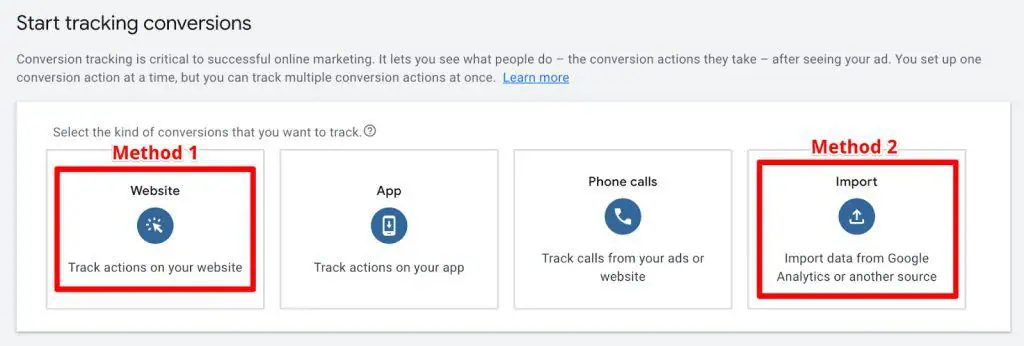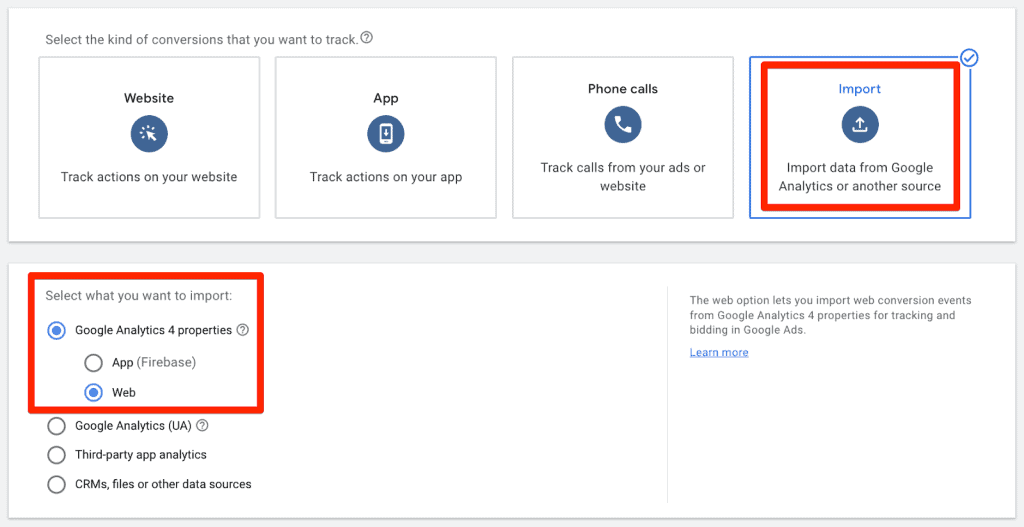Last Modified on November 1, 2024
Google has an arsenal of tools that digital marketers can use depending on what we are trying to achieve.
Chances are that if you’re working in online marketing, you have come across content about Google Ads (GAds) and Google Analytics 4 (GA4) if not used them.
While Google Ads lets you manage your ad campaigns on Google and its partner channels, GA4 helps you get the complete picture of what’s happening on your website.
Both platforms have their versions of conversions as you set up, but which one should you use and why? This is what we will cover in this post along with the following topics:
- Conversion Tracking in Google Ads vs Google Analytics 4
- Difference Between Google Ads vs Google Analytics 4 Conversion Tracking
- Why Use the Google Ads Conversion Tracking?
- Why Use the Google Analytics 4 Conversion Method?
- Choosing Between Google Ads vs Google Analytics 4 Conversions
Let’s get started!
Conversion Tracking in Google Ads vs Google Analytics 4
Conversion tracking means tracking the key actions you want the users to take on your website/app, which can vary for different businesses and industries.
For eCommerce, these could be purchases, and for SaaS businesses, these could be subscriptions, demo requests, etc.
Conversions don’t necessarily have to be something that is only the end goal.
Sometimes actions leading to the main conversion event can also be considered a secondary or micro-conversion – add to carts, filling in shipping and/or payment info, and so on.
So, if you’re not measuring these actions, you won’t be able to measure the performance of your website and any marketing campaigns.
There are two ways you can track conversions in GAds:
- Directly by generating conversion label and ID
- Indirectly by import conversions from GA4

For the first method, you have to add the code snippets to your website either directly or with a tool like Google Tag Manager using the Conversion ID and label:

If you select the second method to import conversions from GA4, you will have to link it to your GAds account first.

But it can be confusing if you want to track the same conversion actions via different platforms, i.e., GAds and GA4, especially when the numbers are different.
So, why can there be these differences between these two platforms that are owned by the same company?
Differences Between Google Ads vs Google Analytics 4 Conversion Tracking
There could be several reasons why there’s a difference between the conversion data on both platforms, but let’s have a look at the major ones:
- Attribution models – Currently, both GA4 and GAds have only Last Click and Data-Driven Attribution (DDA) models available. So, if you’re using different models in both, your conversion numbers will be different.
For instance, if a user sees your ad, visits the site, abandons it, and comes back through organic search, then as per last-click attribution Organic Search will get the credit. But, if the user comes directly, then Paid Search will get the credit.
- Key event window – Aka, the lookback window. This is how far a touch point is given credit for a conversion (renamed to key events in GA4). By default, it is 30 days in GAds and 30 days for acquisition key events (first_visit and first_open) in GA4, but 90 days for other key events. If you’re using different lookback windows, the numbers won’t match.
🚨Note: Conversions have been renamed in GA4 as Key events, but will still be referred to as conversions when shared/exported to GAds.
- Different Conversion Dates – GAds give credit to conversions based on the date the ad was clicked, where whereas GA4 gives credit on the date the conversion happened. So, if a user saw an ad on 21st March and filled a form on 25th March, then GAds will record it under 21st. GA4, on the other hand, will record it under 25th. This difference in attribution dates can cause discrepancies.
- Processing Times – In GAds, conversions are reflected quicker than GA4 which can take 24-48 hours (sometimes even 72 hours) to reflect, causing discrepancies until it’s processed.
- Counting Method – Depending upon how you’ve selected the counting method, i.e., count every conversion or only one conversion in the same session, it can affect the data you see on both platforms. For instance, if you use count every conversion in GA4 for the event, but use count only once in GAds, the data will be quite different.
- Refunds – If you’ve set up tracking for refunds on one platform but not another, the numbers would be different due to refunded transactions.
- Length of Event Name – If the length of the GA4’s event name is more than 40 characters, Google won’t be able to append it with “_c” to mark it as conversion, so it won’t be counted. But, GAds would still count it.
- Cross-device Tracking – While GAds tracking mechanism allows for cross-device tracking, GA4 can only do that if Google Signals are enabled.
- Conversions Not Tracked in GA4 – Conversions coming from phone calls, and view-through sources are available in GAds. GA4 can only track conversions that happen on the website/app. So, these won’t be accounted for.
- User Consent and Ad-Blockers – If a user doesn’t consent to be tracked on the website or uses ad-blocking extensions, then GA4 won’t be able to place the tracking cookie and won’t be able to record user interactions let alone conversion events. GAds can circumvent this issue as its tracking code is only fired when the conversion event happens.
- Reporting Freshness – This isn’t the same as the processing times. It refers to how soon GAds conversion numbers are reflected in the reports (normally 3 hours). On the other hand, conversions imported from GA4 in the GAds account can take up to 9 hours to show up. This is why it’s not recommended to make any decisions on recent data.
- Conversion Exclusions – GAds can exclude conversion data if it detects the ad clicks to be malicious, but they will still show in GA4. Moreover, if there are any test conversions by devs, CROs, etc. on the main website, they can inflate the numbers in GA4 but not GAds. Therefore, it’s recommended to have a test property to send any test data.
There could be other reasons as well, like the GA4 config tag not working, conversion tracking set up wrongly, data sampling in GA4, and the specific business situations that can cause these discrepancies.
Why Use the Google Ads Conversion Tracking?
There are a few reasons to use GAds conversion tracking that could be derived from some of the reasons that lead to data discrepancies between both platforms as discussed above.
Here are some major reasons for you to use it:
- Unlike GA4, GAds tracking doesn’t rely on client-side tracking, so it cannot be affected if visitors use privacy tools or any ad blockers that can stop the GA4 config tag from firing.
- It provides rich data for modeling, so the predictions are better if you want to use automated bidding strategies.
- Certain conversion types have their data available only in GAds, like phone calls and view-through which you won’t get with GA4.
- You can see conversion data quicker with Google Ads vs Google Analytics 4 conversion tracking.
- GAds tracking accounts for cross-device conversions as well, which might not work for GA4 if Google Signals is not enabled.
- The length of the event name isn’t affected by the limit of 40 characters, as GA4 appends “_c” to mark an event as a conversion. If it can’t, then it won’t be counted (generally not a big issue if events are named properly).
- Importing your GA4 conversions to GAds might also save you the pain of going back and forth between the two tools, as you can see it all in GAds.
- Other limitations like the config tag not working and data sampling in GA4 don’t affect GAds conversion tracking.
- In certain internet circles, it is also said that the GA4 conversion data undercounts conversions compared to GAds, which provides a more accurate picture.
These are some solid reasons why we should be leaning towards GAds conversions but what’s the case for GA4 conversions? We look into it in the next section.
Why Use the Google Analytics 4 Conversion Method?
Importing conversions into your Google Ads account can have some positive impacts as well. Let’s see how that can happen:
- Using GA4 conversions can be quick and easy without doing any additional tracking setup for GAds conversions.
- GA4 tracking provides a more holistic view of traffic sources’ performance and doesn’t look at only GAds (google/CPC) as the source.
- GAds can use the data provided by GA4 to optimize for smart bidding.
- You can look at conversions that are not entirely related to GAds, yet provide an overview of different engagement actions on the site or app.
When you import GA4 conversions into Google Ads, they are marked as “secondary conversions” and not used for bidding optimization, etc. So, you should mark them as “primary,” if that’s what you want to do.
This brings us to the million-dollar question (or more depending on your ad budget) – which one to use?
Choosing Between Google Ads vs Google Analytics 4 Conversions
We can get the best of both worlds by using Google Ads conversion tracking for a more accurate picture of what’s happening with the ads, as well as use that data for bidding strategies and campaign optimization.
Google Analytics 4 conversions can be imported and used as “secondary” where they are observed in the reports, but not used for campaign optimization.
This setup can take a little extra effort with the initial tracking setup; but in the end, you get data from two sources. That isn’t necessarily a bad thing as they are still separate.
The important thing is to be aware of the nuances and why there could be data differences between both Google products when it comes to making decisions about your campaigns.
You can have more flexibility whereas if one source breaks, you still have data from another (no absolute gaps) and you can see GAds data in GA4 reports and vice versa.
Now, unless you only run GAds and don’t have any conversions set up in GA4 (which isn’t recommended), then you can only use GAds conversions. However, it would be better to include web analytics as part of your digital marketing strategy.
Summary
In this post, we discussed what conversion tracking in GAds is and how GA4 conversions can be imported into Google Ads, which led us to learn some major reasons for data discrepancy between both platforms.
We then looked at how using GAds conversions can be helpful and what GA4 conversions bring to the table considering they have different purposes to serve.
Finally, we explored which option of conversion tracking would work best and landed on the recommendation to use both of them to have more data, accuracy, and flexibility.
So, if you’re looking to set up GAds conversion tracking, check out our post on Google Ads Conversion Tracking with Google Tag Manager.
What conversions do you use in your Google Ads account? How does it affect your data? Let us and our readers know in the comments!






Thanks for the video, totally understood how to setup tracking now 😉
I wonder if now, both ways: importing conversion from Analytics or using direct Google Ads conversion tag deliever the same data. With the first approach we can set up the atribution model and the same option is available for Google Ads conversion.
Hey Piotr! This is a good question indeed, as now an attribution model can be selected in Google Analytics, but we should also take into consideration the cookie consent aspect. Users might be using ad blockers or other tools to block Analytics. In addition, many users might reject Analytics cookies in order not to be tracked. Even if the same models are applied, numbers may also not match due to the click-through conversion window settings in Google Ads. Thus, data discrepancies can be experienced anyways.
Thanks Julian, this cleared up quite a bit of confusion for me. What I am still struggling with is the ‘Include in conversions’ option is no longer there for me?
I have a GAnalytics imported goal for transactions and also a goal set up in Google Ads, so I’d like to make sure I’m not getting duplicate conversions.
Is it now the primary/secondary action thing? And if so I should be putting Google ads Conversions as primary, and Analytics goal as secondary?
Huge thanks!
Hi Sophie! You are absolutely right. This is a new Google Ads update with primary/secondary actions introduced instead of the ‘include in conversions’ option. Basically, if you mark your conversion as a primary action, it will be used for campaign optimization, whereas secondary actions will be shown in the report for analysis only. In your case, you should mark imported goals as secondary to avoid duplicate conversions.
Thanks for this great article. We are importing offline conversion events from GA (we send these events to GA using the measurement protocol). One issue we are dealing with however is that sometimes we are seeing GAds attribute a conversion to the first known paid session instead of the last know one. So if a user had multiple paid sessions before converting, it shows up in GAds for the date of the first session. Not sure if GA or GAds is doing this, but we have our GAds conversions set to use Last-Click attribution. How can we make it so… Read more »
Hello Julian,
Wondering if this article is applicable to GA4 as well ?
Hi! Thanks for the article! Regarding this – super important – distinction between Ads and Analytics conversions:
Do you have a source for this? I read it on one or two other blogs, but at google no-one can really confirm it, nor is anything specifically mentioned in the google documentation. Thanks already.
This Google article could be helpful.
Hello, thanks for this! What a happens if you have both methods installed? Are conversions duplicated or more accurate? (i’d rather not try it)
This would not harm since you have the option to mark your conversions as primary/secondary actions in Google Ads. If you mark your conversion as a primary action, it will be used for campaign optimization, whereas secondary actions will be shown in the report for analysis only.
What are your thoughts now with GA4? Would you still suggest setting up conversions directly in Google Ads vs importing from GA4?
Hey there! Is attribution actually changing the number of conversions in GAds or GA4? Both are implemented as Events on the website: e.g., clicking on form submit -> Event Tracked -> Conversion/Key Event. Attribution just gives credit to the “channel” that is most likely responsible for the conversion.
Could you elaborate how different attribution models change this behavior and therefore lead to different amount of conversions?
Thanks : )
Hi. Thank you for your content.
I’ve got a question: in some GAds accounts I notice that imported GA4 purchase conversion has a different data than I see throw in GA4! Why? I.e last 7 days: GA4 conversion shown in GADS Goal is 10 Conversions. In GA4 Traffic Acquisition shows 5 conversions pruchase attributed to Google Ads (google/cpc).
Have you any raccomandions?
Hi Roberto,
It could be that you using Session Sources./Medium instead of Source/Medium, I’ve done that a few times.
Source/Medium is much closer (if not identical) to the number in Google Ads, but is only present for Conversions / Key Events.
I hope that helps 🙂
Hi Roberto,
Thank you for your comment. I would agree with Sim on this one, Session Source/Medium dimension is sessionized (as in the name) but Source/Medium on its own is event-based and is only conversions so the numbers will be different.
Let us know if you notice any change when you use that.
This point appears to be mostly false, and could be worth clarifying: Unlike GA4, GAds tracking doesn’t rely on client-side tracking, so it cannot be affected if visitors use privacy tools or any ad blockers that can stop the GA4 config tag from firing. I can’t find any sources backing this up, and it doesn’t make any sense to begin with. G-Ads conversions that are for the same events as GA4 conversions will still be blocked by adblockers. The only difference is for the conversions that can’t be measured from GA4 anyway, like lead forms on google and events not… Read more »
Hi Sim, thank you for your feedback. Yeah, I see what you mean here. We’ll edit the post to clarify this. Keep sharing your comments like this!
I have both GA4 and G-Ads set as a primary action for purchase conversions. Would you reccomend only using one as a primary action? Can using both help with bidding optimization?
Hey Michael, that’s an interesting question. While you can technically do that, it’s not recommended because if you use both of them, then it will be double-counting conversions for bidding. Not to mention that both platforms measure them differently. Lastly, even conversion values can be different for instance, GAds will have no shipping added to it, but GA4 will have it.
Hope this helps!